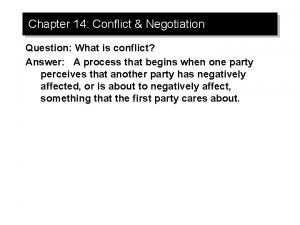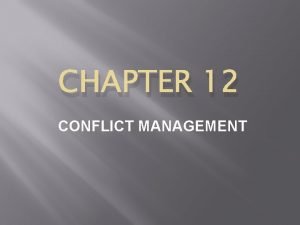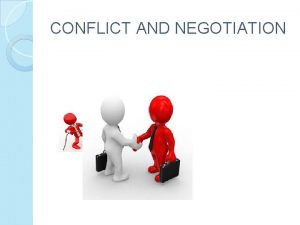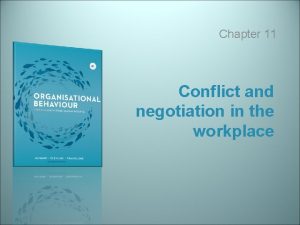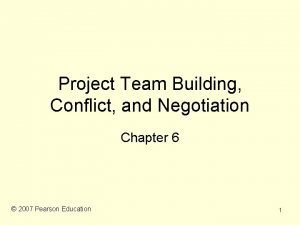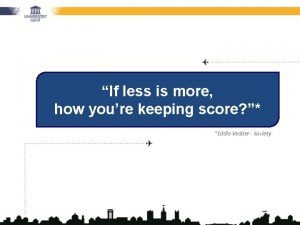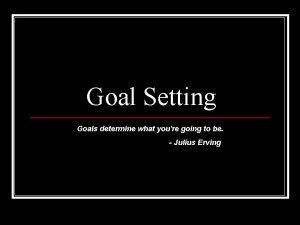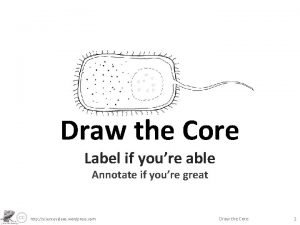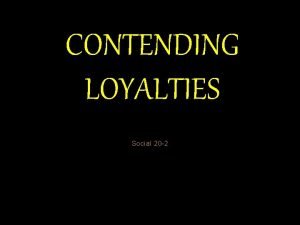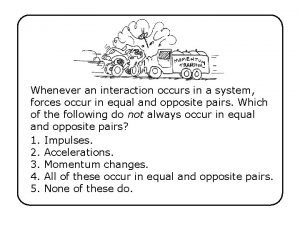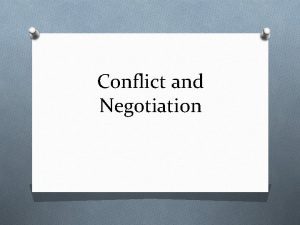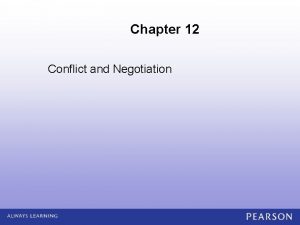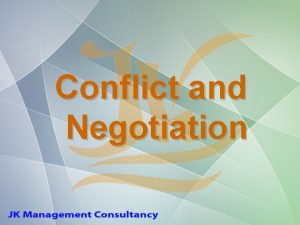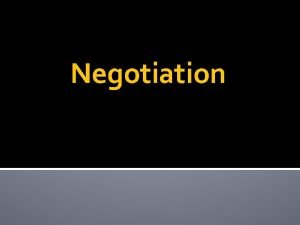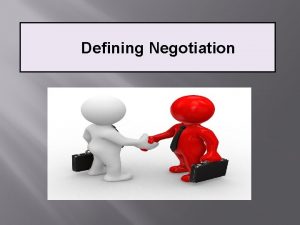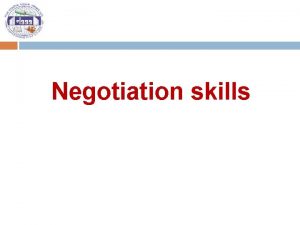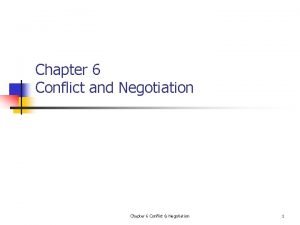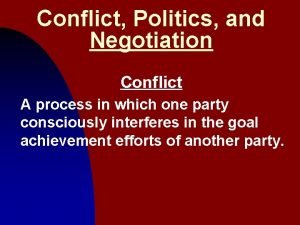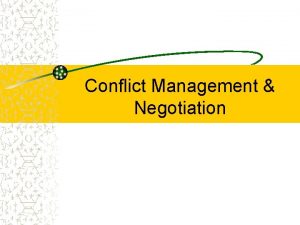Chapter 12 Conflict and Negotiation Whenever youre in





























- Slides: 29

Chapter 12 Conflict and Negotiation

“Whenever you’re in conflict with someone, there is one factor that can make the difference between damaging your relationship and deepening it. The factor is attitude. ” William James

OBJECTIVES • Define conflict and its impact on performance • Name and describe the various conflict management styles and the appropriate time to utilize each one • Describe the process and purpose of negotiation • Define the various forms of workplace harassment • Identify resources available to employees who are confronted with workplace harassment • Describe how to deal with a hostile work environment or a workplace bully • Name warning signs of workplace violence

CONFLICT § Conflict: disagreement or tension between two or more parties (individuals or groups) – A perceived threat to one’s needs, interests, or concerns – Individuals are looking at a situation from different perspectives

RESOLVING CONFLICT • Do not make conflict personal • Avoid making assumptions about the individual and/or situation • Clarify facts • Be willing to resolve the issue

RESOLVING CONFLICT Basic Rules 1. Resolve in person when possible 2. Remain calm and unemotional 3. Be silent and listen 4. Try to view the disagreement from the other person’s perspective 5. Explain your position and offer a solution 6. Come to a solution

RESOLVING CONFLICT • Emotions make it difficult to logically resolve an issue – Remain calm and unemotional – Acknowledge hurt feelings or anger – Do not let the anger or hurt dominate your response – Look for facts and feelings – Identify where communication broke down

RESOLVING CONFLICT • Basic concepts to deal with conflict: – Only you can control your response – Do not let feelings dictate actions – Attempt to resolve conflict immediately – Accept responsibility for actions – Apologize if necessary – Retaliation is not the answer – Keep your conflict issues confidential

RESOLVING CONFLICT • If the conflict negatively affects your performance: • Document the offensive behavior • Seek assistance within the company • If necessary, seek outside assistance

CONFLICT MANAGEMENT AND NEGOTIATION • Forcing conflict management style: deals with issue directly, trying to get your way • Avoiding conflict management style: offense is ignored • Accommodating conflict management style: allow other party to have his/her way without knowing there was a conflict

CONFLICT MANAGEMENT AND NEGOTIATION (Cont. ) • Compromising conflict management style: both parties give up something of importance to arrive at a mutually agreeable solution • Collaborating conflict management style: both parties work together to arrive at a solution without having to give up something of value

CONFLICT MANAGEMENT AND NEGOTIATION • Negotiation: creating a solution that is fair to all involved parties • Mediator: a neutral third party that helps resolve a conflict • Both sides come to an agreement if both parties: – Want to resolve an issue – Agree on an objective – Honestly communicate their case/situation – Listen to the other side – Work toward a mutually beneficial common solution

CONFLICT MANAGEMENT AND NEGOTIATION • Assertive behavior: standing up for your rights without violating the rights of others • Passive behavior: consistently allowing others to have their way, avoiding conflict • Aggressive behavior: standing up for your rights in a way that violates others’ rights

TALK IT OUT How can you become more assertive?

HARASSMENT § Sexual Harassment: offensive, humiliating, or intimating behavior • Types of sexual harassment: – Quid pro quo: payback for a sexual favor – Hostile behavior: any behavior of a sexual nature that is offensive • Harassment can occur between: – Boss/employee – Man/woman – Woman/woman – Man/man

HARASSMENT If You Are a Victim 1. Minor harassment—tell individual you are offended and ask them to stop 1. 2. Document action If behavior continues or is extreme, immediately contact supervisor or HRM department 1. 2. File formal harassment charges Provide facts and names of witnesses

HARASSMENT The Complaint Process • Complaint is filed • Confidential investigation occurs • Share factual, documented events • Supervisor/HRM will render an outcome

HARASSMENT Employee Rights • Harassment Free Workplace • Equal Employment Opportunity Commission (EEOC) - federal agency • Department of Fair Employment and Housing - state agency • Employee unions • Unlawful to retaliate against anyone who files a claim, even if claim is without merit

HARASSMENT Be Aware of Employer Actions • Harassment policies • Harassment training • Report inappropriate behavior • An employer cannot help you if he or she is not aware of the problem

WORKPLACE BULLIES • Workplace Bullies: employees who are behaving in an offensive, humiliating, or intimating manner – Workplace incivility – Bullying and incivility are inappropriate in the workplace

WORKPLACE BULLIES Dealing with a Bully • Do not retaliate with poor behavior • Document dates, words, and witnesses • Share factual documentation with boss or HRM department and file a formal complaint • If company fails to deal with situation in a reasonable time and manner, seek outside assistance

KNOW YOUR RIGHTS • Legal right to work in an environment free from harassment, discrimination, and hostility • Share concerns with supervisor and exhaust internal remedies before going to government agencies: – State’s Department of Fair Employment and Housing – Equal Employment Opportunity Commission – State Personnel Board – Department of Labor/Labor Commission – Department of Justice

RESOLVING CONFLICT AT WORK Coworker • Resolve directly with other individual • If unresolved, inform immediate supervisor • If situation worsens, formally file a complaint with the HRM department • Seek assistance from an outside source Immediate Supervisor Human Resource Department Outside Agency or Private Attorney Figure 12 -1

CONFLICT UNDER A UNION AGREEMENT • Union Terms: – Shop Steward: a coworker who is very familiar with the union contract and procedures available to assist you in resolving a workplace conflict – Grievance: a problem or conflict that occurs in a unionized workplace – Grievance Procedure: formal process of resolving a union-employer conflict

CONFLICT UNDER A UNION AGREEMENT • Union exists to protect employee rights • Refer to union contract • Confer with shop steward • If there is a violation of policy, a formal grievance is filed • Employee, steward, and supervisor meet • If unresolved, a union official will meet with the HRM department • If unresolved, attorneys from both sides (union and employer) will meet

WORKPLACE VIOLENCE • A result of unresolved conflict • Includes any kind of harassing or harmful behavior (verbal or physical) • Workplace violence can come from: – – Coworkers Bosses Customers Family

WORKPLACE VIOLENCE Warning Signs • Be aware of your surroundings • Keep work area and access well-lit • Request an escort to your car if necessary • Keep emergency phone numbers posted in visible areas • Report suspicious behavior or situations • It is better to be safe than sorry

WORKPLACE VIOLENCE • Employee Assistance Program (EAP): a benefit offered by many employers that provide free and confidential psychological, financial, and legal advice – If you are experiencing a stressful situation at work or home, take advantage of this benefit

AGREE TO DISAGREE • Conflict frequently can’t be avoided • Apologize if you are wrong • Forgive if you have been harmed • Mature coworkers are willing to forgive and not hold grudges We don’t have to like all our colleagues, but we must demonstrate professionalism and show respect to them
 Integrative vs distributive negotiation
Integrative vs distributive negotiation Conflict occurs whenever
Conflict occurs whenever The conflict process begins:
The conflict process begins: Negotiation in the workplace
Negotiation in the workplace Project team building conflict and negotiation
Project team building conflict and negotiation Conflict management and negotiation skills
Conflict management and negotiation skills Negotiation conflict styles by calum coburn
Negotiation conflict styles by calum coburn Hope youre doing well
Hope youre doing well What to do when you're angry
What to do when you're angry Hello everyone how are you all
Hello everyone how are you all Firm foundation
Firm foundation Random compliment generator
Random compliment generator Jesus is my master
Jesus is my master I dont know where youre going
I dont know where youre going Am i asexual
Am i asexual Together we are strong love is the answer
Together we are strong love is the answer How youre
How youre Tentative goal statement
Tentative goal statement Use the labels to draw and annotate a cell membrane
Use the labels to draw and annotate a cell membrane Im ok youre not ok
Im ok youre not ok You love going to soccer practice every friday night
You love going to soccer practice every friday night What is conflict and conflict resolution?
What is conflict and conflict resolution? External and internal conflict definition
External and internal conflict definition I will always follow you whenever and wherever you go i am
I will always follow you whenever and wherever you go i am Padi quiz 3 answers
Padi quiz 3 answers Nationalist loyalties
Nationalist loyalties Whenever the weather
Whenever the weather Whenever an interaction occurs in a system
Whenever an interaction occurs in a system Whenever jon delivers a newspaper to the zapanta house
Whenever jon delivers a newspaper to the zapanta house Thamo conjunction
Thamo conjunction
